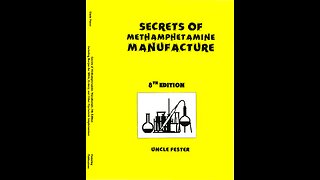Premium Only Content

A PRACTICAL TOTAL SYNTHESIS OF COCAINE'S ENANTIOMERS. JOHN F CASALE.
Forensic Science International, issue thirty three.1987, pages 275 to 298.
A PRACTICAL TOTAL SYNTHESIS OF COCAINE'S ENANTIOMERS.
JOHN F CASALE.
State Bureau of Investigation.
Accepted December tenth, 1980.
Summary.
A simplified total synthesis of the single enantiomers of cocaine and racemic cocaine is outlined. The synthesis employs common laboratory glassware, reagents, and methods which can be performed in most forensic laboratories. The procedure for the isolation and purification of the dextrorotatory enantiomer of cocaine is presented.
Key words: Cocaine; Enantiomers; Total synthesis.
Introduction.
In many jurisdictions cocaine is listed as a controlled substance under statutes covering coca leaves and their extracts. Therefore only the levorotatory isomer of cocaine would be controlled. These laws do not include optical isomers and dia-stereoisomers. The question of enantiomeric composition has recently become popular with defense attorneys. Minus Cocaine is the naturally occurring alkaloid extracted from coca leaves. Racemic and Plus cocaine can only be obtained through a chemical synthesis.
The molecular structure of cocaine was first described by Willstatter and Muller, reference one in 1898. It was not until the early 1950's that the principles and methodologies of stereochemistry were applied to cocaine's tropane ring skeleton. Findlay, reference two, Fodor reference three four, and others established the stereochemistry of the tropane alcohols and their esters. Once this groundwork was laid, the three-dimensional structures of cocaine and its dia-stereoisomers, pseudo-cocaine, alloco-caine, and allo-pseudo-cocaine, were elucidated by Findlay references five to seven and Hardegger et at, reference eight. Findlay's three-dimensional structures were confirmed in 1968 by Sinnema et at reference nine using NMR spectral analysis. Electron impact fragmentation patterns of the tropane alkaloids were later established by Blossey et al. reference ten. These workers identified the major mass spectral fragmentation patterns by deuterium and substituent labelling.
Fragmentation patterns for various tropinone analogs have also been determined by Kashman and Cherkez, reference eleven.
-
 13:47:30
13:47:30
PukeOnABook
11 days agoSecrets of Methamphetamine Manufacture, by Uncle Fester
741 -
 LIVE
LIVE
Side Scrollers Podcast
1 hour agoMario Galaxy Movie Trailer REACTION + Black Lesbian GOES OFF on Weiner + More | Side Scrollers
629 watching -
 15:49
15:49
Rethinking the Dollar
1 hour agoThis Crypto ‘Freeze Code’ Warning Changes Everything
501 -
 1:10:03
1:10:03
The Rubin Report
2 hours ago‘The View’s Sunny Hostin Tries to Shame John Fetterman Until He Puts Her in Her Place
89.8K40 -
 LIVE
LIVE
LFA TV
15 hours agoLIVE & BREAKING NEWS! | WEDNESDAY 11/12/25
4,161 watching -
 18:53
18:53
Professor Nez
1 hour agoDemocrats TURN on Chuck Schumer & BOOT HIM OUT of the Party!
7.31K6 -
 LIVE
LIVE
The Mel K Show
1 hour agoMORNINGS WITH MEL K - Dueling Narratives & Endless Distraction: Don’t Lose Focus! - 11-12-25
717 watching -
 LIVE
LIVE
The Shannon Joy Show
1 hour agoH1-B-Trayal! How Many Times Does Trump Have To Punch MAGA In The Face Before They Realize He’s Just Not That Into Them?
241 watching -
 1:56:53
1:56:53
Badlands Media
11 hours agoBadlands Daily: November 12, 2025 – Epstein Emails, COVID Lies & Constitutional Chaos
90.1K9 -
 43:54
43:54
VINCE
3 hours agoThomas Speciale: The Man Behind John Brennan's Meltdown | Episode 167 - 11/12/25 VINCE
73.4K116